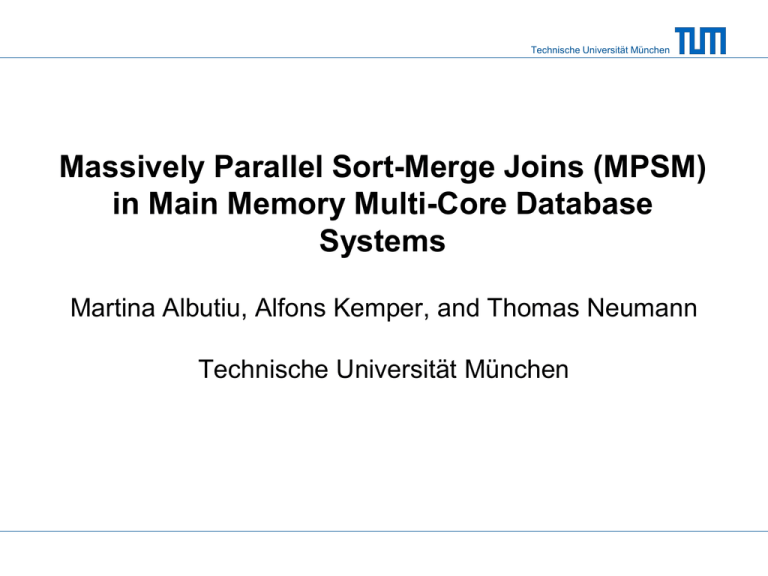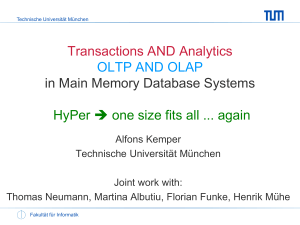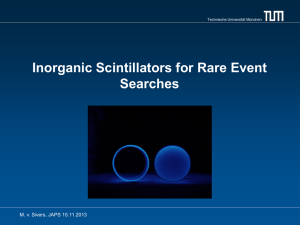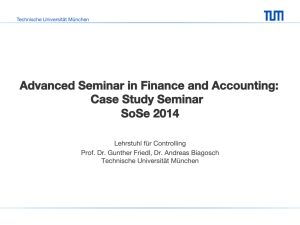MPSM - Technische Universität München
advertisement

Technische Universität München
Massively Parallel Sort-Merge Joins (MPSM)
in Main Memory Multi-Core Database
Systems
Martina Albutiu, Alfons Kemper, and Thomas Neumann
Technische Universität München
Technische Universität München
Hardware trends …
• Huge main memory
• Massive processing
parallelism
• Non-uniform Memory
Access (NUMA)
• Our server:
–
–
–
–
4 CPUs
32 cores
1 TB RAM
4 NUMA partitions
CPU 0
2
Technische Universität München
Main memory database systems
• VoltDB, Hana, MonetDB
• HyPer: real-time business intelligence queries on
transactional data*
* http://www-db.in.tum.de/research/projects/HyPer/
3
Technische Universität München
How to exploit these hardware trends?
• Parallelize algorithms
• Exploit fast main memory access
Kim, Sedlar, Chhugani: Sort vs. Hash Revisited: Fast
Join Implementation on Modern Multi-Core CPUs.
VLDB‘09
Blanas, Li, Patel: Design and Evaluation of Main
Memory Hash Join Algorithms for Multi-core CPUs.
SIGMOD‘11
• AND be aware of fast local vs. slow remote NUMA
access
4
Technische Universität München
Ignoring NUMA
core
1
NUMA partition 1
NUMA partition 3
hashable
core
5
core
2
core
6
core
3
core
7
core
4
core
8
NUMA partition 2
NUMA partition 4
5
Technische Universität München
7440 ms
sort
1000 ms
837 ms
scaled
execution
time
12946 ms
417344 ms
100%
22756 ms
How much difference does NUMA make?
partitioning
merge join
(sequential read)
6
Technische Universität München
The three NUMA commandments
C1
Thou shalt not
write thy neighbor‘s
memory randomly
-- chunk the data,
redistribute,
and then sort/work
on your data locally.
C2
Thou shalt read
thy neighbor‘s
memory only
sequentially
-- let the
prefetcher hide
the remote
access latency.
C3
Thou shalt not wait
for thy neighbors
-- don‘t use finegrained latching or
locking and avoid
synchronization
points of parallel
threads.
7
Technische Universität München
Basic idea of MPSM
R
R chunks
chunk R
S chunks
S
chunk S
8
Technische Universität München
Basic idea of MPSM
• C1: Work locally: sort
• C3: Work independently: sort and merge join
• C2: Access neighbor‘s data only sequentially
chunk R
sort R chunks locally
R chunks
MJ
S chunks
MJ
MJ
MJ
merge join chunks
sort S chunks locally
chunk S
9
Technische Universität München
Range partitioning of private input R
• To constrain merge join work
• To provide scalability in the number of parallel workers
10
Technische Universität München
Range partitioning of private input R
• To constrain merge join work
• To provide scalability in the number of parallel workers
R chunks
range partition R
range
partitioned
R chunks
11
Technische Universität München
Range partitioning of private input R
• To constrain merge join work
• To provide scalability in the number of parallel workers
S is implicitly partitioned
range
partitioned
R chunks
sort R chunks
S chunks
sort S chunks
12
Technische Universität München
Range partitioning of private input R
• To constrain merge join work
• To provide scalability in the number of parallel workers
S is implicitly partitioned
range
partitioned
R chunks
sort R chunks
MJ
S chunks
MJ
MJ
MJ
merge join only
relevant parts
sort S chunks
13
Technische Universität München
Range partitioning of private input
• Time efficient
branch-free
comparison-free
synchronization-free
and
• Space efficient
densely packed
in-place
by using radix-clustering and precomputed target
partitions to scatter data to
14
Technische Universität München
chunk of worker W2 chunk of worker W1
Range partitioning of private input
19
9
7
3
21
1
17
2
23
4
31
8
20
26
19=10011
7 = 00111
histogram of
worker W1
4
3
<16
≥16
prefix sum of
worker W1
0
01
2
17 = 10001
2=00010
W1
W2
histogram of
worker W2
3
4
<16
≥16
prefix sum of
worker W2
45
3
19
W1
W2
15
Technische Universität München
chunk of worker W2 chunk of worker W1
Range partitioning of private input
19
9
7
3
21
1
17
2
23
4
31
8
20
26
19=10011
7 = 00111
histogram of
worker W1
4
3
<16
≥16
prefix sum of
worker W1
0
01
17 = 10001
2=00010
W1
W2
histogram of
worker W2
3
4
<16
≥16
prefix sum of
worker W2
45
3
W1
W2
9
7
3
1
2
4
8
19
21
17
23
31
20
26
16
Technische Universität München
Real C hacker at work
…
Technische Universität München
Skew resilience of MPSM
• Location skew is implicitly handled
• Distribution skew:
– Dynamically computed partition bounds
– Determined based on the global data distributions of R and S
– Cost balancing for sorting R and joining R and S
18
Technische Universität München
Skew resilience
1. Global S data distribution
– Local equi-height histograms (for free)
– Combined to CDF
1
7
10
15
22
31
66
81
2
12
17
25
33
42
78
90
S1
S2
# tuples
CDF
16
13
50
key value
19
Technische Universität München
Skew resilience
2. Global R data distribution
– Local equi-width histograms as before
– More fine-grained histograms
2
13
4
31
8
20
6
2 = 00010
8 = 01000
histogram
3
2
1
1
<8
[8,16)
[16,24)
≥24
R1
20
Technische Universität München
Skew resilience
3. Compute splitters so that overall workloads are
balanced*: greedily combine buckets, thereby balancing
the costs of each thread for sorting R and joining R and
S are balanced
# tuples
CDF
histogram
+
3
2
1
1
=
2
4
6
13
31
8
20
key value
* Ross and Cieslewicz: Optimal Splitters for Database Partitioning with
Size Bounds. ICDT‘09
21
Technische Universität München
Performance evaluation
• MPSM performance in a nutshell:
– 160 mio tuples joined per second
– 27 bio tuples joined in less than 3 minutes
– scales linearly with the number of cores
• Platform HyPer1:
– Linux server
– 1 TB RAM
– 4 CPUs with 8 physical cores each
• Benchmark:
– Join tables R and S with schema
{[joinkey: 64bit, payload: 64bit]}
– Dataset sizes ranging from 50GB to 400GB
22
Technische Universität München
Execution time comparison
• MPSM,
Vectorwise (VW),
and Blanas
hash join*
• 32 workers
• |R| = 1600 mio
(25 GB),
varying size of S
* S. Blanas, Y. Li, and J. M. Patel: Design and Evaluation of Main Memory
Hash Join Algorithms for Multi-core CPUs. SIGMOD 2011
23
Technische Universität München
Scalability in the number of cores
• MPSM and
Vectorwise (VW)
• |R| = 1600 mio
(25 GB),
|S|=4*|R|
24
Technische Universität München
Location skew
• Location skew in R
has no effect
because of
repartitioning
• Location skew in S:
in the extreme case
all join partners of
Ri are found in only
one Sj (either local
or remote)
25
Technische Universität München
Distribution skew: anti-correlated data
without balanced partitioning
with balanced partitioning
26
Technische Universität München
Distribution skew : anti-correlated data
27
Technische Universität München
Conclusions
•
•
•
•
•
•
MPSM is a sort-based parallel join algorithm
MPSM is NUMA-aware & NUMA-oblivious
MPSM is space efficient (works in-place)
MPSM scales linearly in the number of cores
MPSM is skew resilient
MPSM outperforms Vectorwise (4X) and Blanas et al‘s
hash join (18X)
• MPSM is adaptable for disk-based processing
– See details in paper
28
Technische Universität München
Massively Parallel Sort-Merge Joins (MPSM)
in Main Memory Multi-Core Database
Systems
Martina Albutiu, Alfons Kemper, and Thomas Neumann
Technische Universität München
THANK YOU FOR YOUR ATTENTION!









